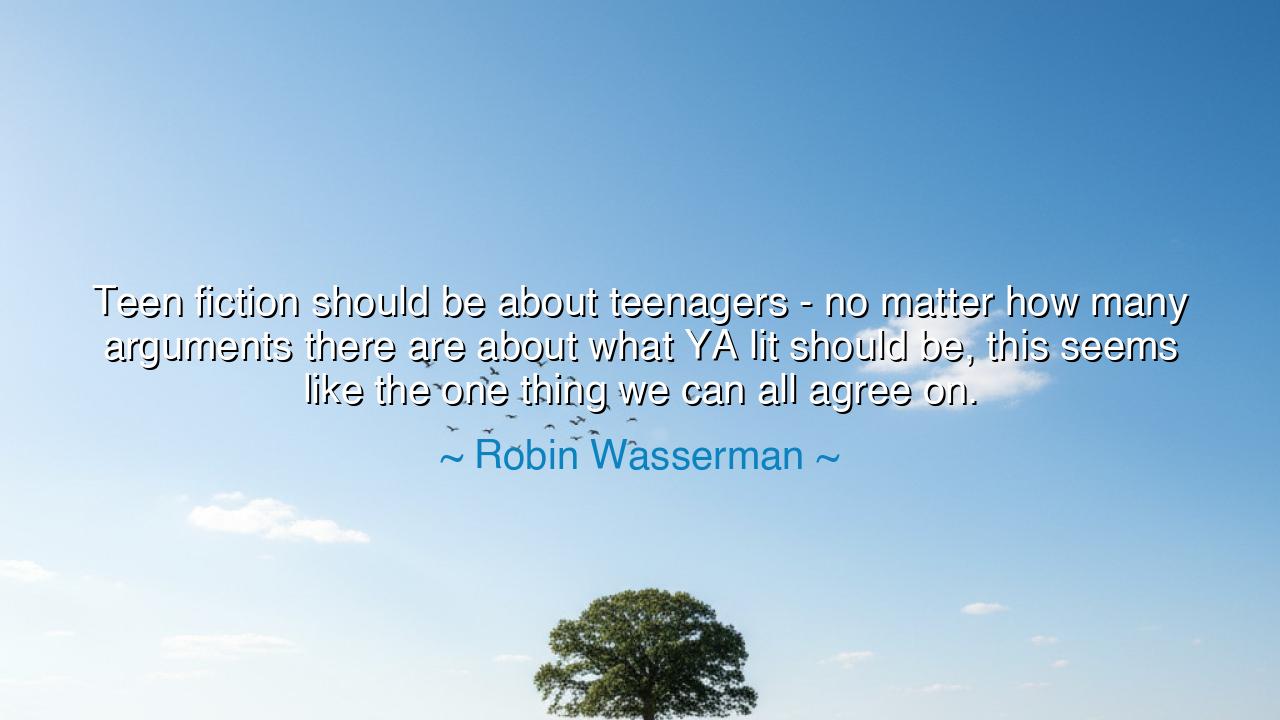
Teen fiction should be about teenagers - no matter how many
Teen fiction should be about teenagers - no matter how many arguments there are about what YA lit should be, this seems like the one thing we can all agree on.






Hear now the voice of Robin Wasserman, who declared with clarity: “Teen fiction should be about teenagers—no matter how many arguments there are about what YA lit should be, this seems like the one thing we can all agree on.” This is no idle remark, but a truth forged in the fires of both art and necessity. For literature meant for the young must first and foremost reflect the young themselves, their struggles, their passions, their mistakes, their triumphs. To deny them that mirror is to silence them; to grant it is to give them a voice in the great chorus of humanity.
Consider what is meant by this word teenagers. They are neither children nor adults, but dwell in the sacred in-between, where innocence and responsibility collide. Their world is charged with discovery: the first taste of freedom, the first brush with love, the first shadow of mortality. It is a time of contradiction—boldness and fear, laughter and despair, rebellion and longing. Thus, to write for them is to write of transformation, for adolescence is not merely an age but a crucible where souls are forged.
Yet, as Wasserman reminds us, many debates arise over what YA literature should be. Some argue it must uplift, others that it must warn; some demand it reflect harsh reality, others that it offer escape and hope. But beneath these quarrels lies one foundation that all must honor: that the center of the tale must be the young themselves. For without their voices, it ceases to be teen fiction at all, and becomes instead a lecture from the outside. The young deserve not sermons but stories—stories that recognize them as heroes of their own journeys.
History itself affirms this truth. Recall Anne Frank, whose diary became one of the most profound works of the last century. She was but a teenager, yet her words carried the weight of nations, revealing both the terror of her time and the eternal strength of hope. Her writing was not crafted for literary categories, nor to satisfy critics, but sprang from the heart of a girl living through her moment. And in that honesty, it became universal. So too must YA lit place the teenager at its center—not as a symbol, not as a lesson, but as a living soul.
The meaning of Wasserman’s words, then, is that literature for the young should not speak about them from afar, but with them, through characters who embody their struggles. The power of a novel lies not in what it dictates, but in what it reveals: that the reader is not alone. When a young person finds themselves reflected in a book, when their hidden fears and secret hopes are given form, they discover strength to continue their journey. And when they encounter characters whose struggles differ from their own, they gain empathy and understanding.
What lesson shall we carry forward? That art must honor its audience. For to write teen fiction without teenagers is to build a temple with no god within it. And to debate endlessly about what it “should” be, without centering the very ones it is meant for, is to lose the heart of the matter. The wise creator listens first, then writes. The wise reader remembers their own youth, and treats stories for teens not as lesser, but as sacred, for they shape the future.
Therefore, let us act. Let writers craft stories that honor the voices of the young. Let teachers and parents not dismiss YA lit as frivolous, but recognize its power to guide and to heal. Let readers of every age return to these books, not with condescension but with reverence, for they hold the raw truth of becoming. And let all remember Wasserman’s wisdom: amidst many arguments, one truth remains unshaken—teen fiction belongs, first and last, to the teenagers themselves.






AAdministratorAdministrator
Welcome, honored guests. Please leave a comment, we will respond soon